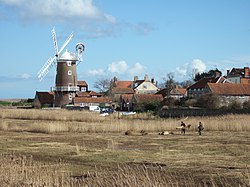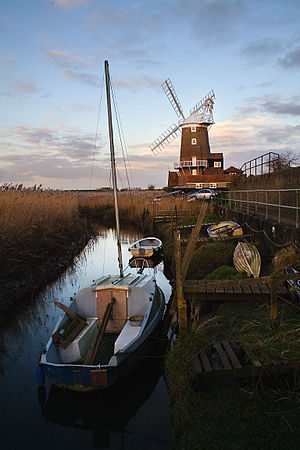Cley next the Sea
| Cley next the Sea | |
| Norfolk | |
|---|---|
 Cley next the Sea | |
| Location | |
| Grid reference: | TG045436 |
| Location: | 52°57’4"N, 1°2’35"E |
| Data | |
| Population: | 376 (est.) |
| Post town: | Holt |
| Postcode: | NR25 |
| Dialling code: | 01263 |
| Local Government | |
| Council: | North Norfolk |
| Parliamentary constituency: |
North Norfolk |
Cley next the Sea is a small village on the River Glaven in Norfolk, 4 miles northwest of Holt and east of Blakeney. The main A149 coast road runs through the centre of the village, causing congestion in the summer months due to the tight, narrow streets. It lies within the "Norfolk Coast Area of Outstanding Natural Beauty" and the "North Norfolk Heritage Coast".
The mediæval church of St Margarets is the largest church in the Blakeney Haven area. A ruined building on the marshes is known as Blakeney Chapel; despite its name, it is in Cley parish, and was probably never a house of prayer.
The village's name is pronounced (ˈkleɪ), from the Old English Clæg, meaning "clay".
History
Despite its name, Cley has not been "next the sea" since the 17th century, due to land reclamation. Some of the buildings that once lined the quay remain, notably the 18th-century Cley Windmill. The windmill has long operated as a bed and breakfast, now on a non-profit making basis. It was used as a backdrop of the 1949 film Conspirator with Elizabeth Taylor. Cley Mill has often been depicted by local artists and was the subject of a painting by the 20th century English landscape artist, Rowland Hilder.
The poet Rupert Brooke was in Cley early in August 1914, staying with the Cornfords - the classics professor Francis Macdonald Cornford and his wife, the poet Frances Cornford - when news came that Britain had entered the First World War. Brooke had dreamt about the war and woke to find it a reality. He did not speak to his hosts all day until Frances Cornford said, 'But Rupert, you won't have to fight?' to which Brooke replied, 'We shall all have to fight',[1] as he did; and on the Isle of Skyros in the Aegean Sea there is "In that rich earth a richer dust concealed, A dust whom England bore, shaped, made aware, Gave, once, her flowers to love, her ways to roam".
Cley Old Hall was used as a location in the 1982 film The Ploughman's Lunch. In July 1997 the BBC filmed one of its BBC One balloon idents, which ran from 1997 to 2002, in the village.
Hard as it may be to imagine, Cley was once one of the busiest ports in England, where grain, malt, fish, spices, coal, cloth, barley and oats were exported or imported. The many Flemish gables in the town are a reminder of trade with the Low Countries. Since the silting up of the port, Cley had to find another industry: in the late 19th century, it became a holiday resort.
Cley Marshes
The marshes around Cley are internationally important for their populations of rare breeding and visiting birds. Cley Marshes bird reserve has been in the care of the Norfolk Wildlife Trust since 1926, making it the oldest county Wildlife Trust reserve in Britain.[2] Among resident breeding birds are Avocet, Bearded Tit, Bittern, Marsh Harrier and Spoonbill. Winter visitors include Brent Geese, Wigeon, Pintail and many species of wading birds. Cley, like neighbouring Salthouse, is ideally situated at the apex of the North Norfolk coast as a staging ground for passage migrants, vagrants and rareties of all kinds. A new eco-friendly visitor centre opened in 2007 containing a café, shop, viewing areas (including viewing from a camera on the reserve), exhibition area, interpretation and toilets. The view from the visitor centre across the Marsh to the sea is breathtaking. Cley Marshes are the home of the Bird Information Service, publishers of Birding World.
The shingle bank holds large numbers of Yellow Horned Poppy.
Sea defences
The salt and fresh water marshes used to be very well protected. However the cost of replenishing the shingle spit grew too much for the village to sustain. Once the repairing stopped, it became easier for waves to get through; in 1953 a large storm, measured at 5.12 metres above ordnance datum (see North Sea flood of 1953) hit the North Norfolk coast and the shingle ridge was mostly destroyed. A further storm surge in 1978 measured 4.19 metres above ordnance datum and the protection measures confined flooding to the marshes and A149 coast road. The North Norfolk Shoreline Management Plan introduced by the Environment Agency has proposed a number of strategies in the light of continual erosion and predicted rising sea levels caused by global warming: these include Advance the line, Hold the line, Managed retreat and Do nothing. Even after extensive public consultation there is widespread local concern that the marshes, with their unique wildlife, will be irretrievably lost to the predatory North Sea.
Outside links
| ("Wikimedia Commons" has material about Cley next the Sea) |
- Photographs of Cley
- Cley windmill history
- Ornithologist - poem inspired by Cley
- Daily Mail article: a White-crowned Sparrow, commemorated in the church window
References
- ↑ Hollis, Matthew: Now All Roads Lead to France - The Last Years of Edward Thomas, Faber & Faber, London, 2011
- ↑ "Cley Marshes". Norfolk Wildlife Trust. http://www.norfolkwildlifetrust.org.uk/Wildlife-in-Norfolk/Reserves/Cley-Marshes.aspx. Retrieved 2013-03-26.
